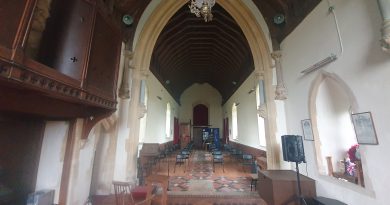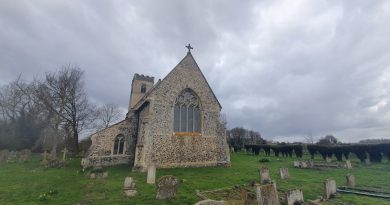Forncett St Mary – St. Mary’s Church
I didn’t really understand this church when looking around it, there was a feel of some rather stark and blunt repairs to the building and an interior which seemed a little whitewashed. But, equally, it was in a good state of repair, a big effort had been made to put up some boards with some history and it all seemed in order. The true story of this church is though remarkable, it has been saved by the community after having fallen derelict. I’m deeply impressed at what has been done here over the last few years, and it explained why so many repairs had been needed. All really quite wonderful. Simon Knott has some photos of the state that this church was in just a few years ago and George Plunkett has a photo from 1992.
The church on an old tithe map and it’s set back a fair way from the road.
The church had fallen into a state of disrepair even though it is Grade I listed, with the bulk of the building dating to the thirteenth century, but the tower is a fifteenth century replacement from what stood before. The listed building record notes though that some elements of the nave are from the eleventh century, survivors of the earlier church.
The chancel, which was repaired during an extensive 1869 restoration, led by the Reverend J Cooper. There were no end of events that took place in 1868 to raise funds for the repairs, showing some of the community effort that has again been notable in recent years.
The Norwich Mercury reported in April 1870 about the reopening of the church and I like their general comment that “advantage has been taken of the necessary alterations and re-buildings which churches require to graft upon them the whims and fancies of architects, so that we have had a series of abominations perpetrated, at which none are now more ashamed than the clergymen themselves”.
Fortunately, the newspaper liked the work that had been done at St. Mary’s, commenting that the architect JP Pearce had “followed and adhered to the plan of the original building”. The work had cost £1,000 and the chancel in particular had been heavily restored and a new chancel arch added, with new carvings and stoneworks throughout the church. The newspaper remarked that the thatched roof which “gave the church a poverty stricken look” had been replaced and new Staffordshire tiles had been laid in the chancel and nave.
A blocked-up window, perhaps a victim long ago of wanting a window with a more modern design.
The porchway has now been repaired and is in a good state of repair given how it looked just a few years ago in Simon Knott’s photo.
The church was open and it one of those atmospheres which just felt welcoming, and I liked how there were some history boards up giving further information about John William Colenso. He was the rector of this church between 1846 and 1853 and he went on to become the first Bishop of Natal, in South Africa, a role he remained in until 1883.
The inside of the church, looking towards the tower. The floorboards have had to be replaced as they had become damaged during the period that the church was derelict, but some of the tiles from the 1869 restoration are still visible.
And looking along the nave into the chancel.
There’s something really quite environmental (if that’s the right word there, perhaps not) about how someone’s remains can help the growth of a fine tree. I didn’t notice any early burials, so everything was from the nineteenth century onwards, but there’s an interesting note at the Heritage Norfolk web-site which mentions:
“Burials did take place prior to this period but headstones were rarely used and multiple burials often occupied the same plot.”
This helps answer my ongoing question about why are there are often so few headstones in churchyards in Norfolk, and perhaps it’s for the same reason here, that headstones were rarely used and the graves not always carefully marked.
The new lych gate, with a chunky bench, all of which offers a positive first impression for visitors to the church.
All in all, this is a glorious restoration and saving of a church which had become redundant in 1985 and then sadly vandalised in the years that followed. It’s disappointing that the Church of England abandoned this church, and they were talking about turning the building into a holiday cottage at one stage. Fortunately, things are much better again today, and what a marvellous community effort to bring this church back from the brink.














